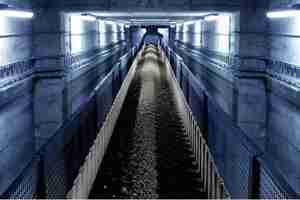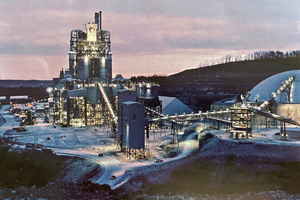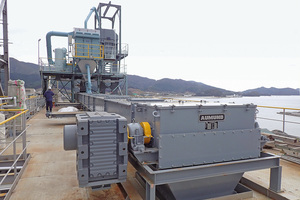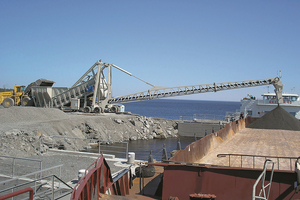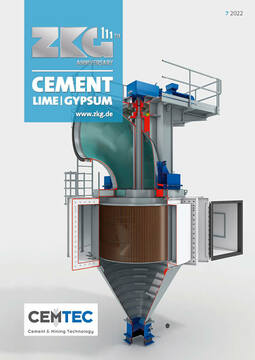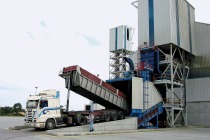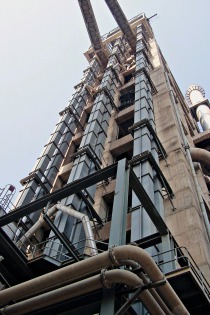100 years of Aumund: How an inventor and engineer’s office became an international conveying and storage technology brand
On 3 August 1922 Heinrich Aumund founded the company for Aumund-Patente MB.H. in Berlin, an invention and engineering office, which laid the cornerstone for the globally operating Aumund Group of companies, today employing around 500 people of more than 30 nationalities. With approximately 24000 references in around 150 countries, the Aumund Group is one of the global players and technology leaders in high-performance conveying and storage of bulk materials. At first Aumund established itself as a global brand in the cement industry, and followed on into the most varied of other key bulk materials industries internationally.
Today Aumund Group machines, systems and process technologies are in operation in metallurgy, mining and minerals, lime and gypsum, chemicals – in particular fertiliser, foundries, power plants, agribulk, ports and terminals, as well as in the area of alternative fuels with its current significance in environmental politics and environmental technology. The 100-year history and development of Aumund spans three generations and is inextricably linked with the business leaders Prof. Dr.-Ing. h.c. Heinrich Aumund, Günter-Claus Aumund and Franz-W. Aumund, who is currently Chairman of the Advisory Board.
The global conveying and storage business is currently driven internationally by 20 locations in Europe, North and South America and Asia, supported by five ServiceCentres in Germany, Hong Kong, USA, Brazil and Saudi Arabia, and reinforced by approximately 80 representations and a network of around 100 supervisors and inspectors who advise on and accompany installation, commissioning and on-site inspections with the Premas® Preventive Maintenance Service for Aumund, Schade and Samson machines as well as for those of other manufacturers.
Effective mid-2022, after 100 years of family management Franz-W. Aumund, who had been Managing Proprietor of the Aumund Group for 38 years, has handed over his operational activities to the Management of Aumund Fördertechnik, in the persons of Dr Pietro de Michieli, Reiner Furthmann and Uwe Altena.
Dr Pietro de Michieli has been Managing Director Sales for four years and has now been appointed additionally as CEO of Aumund Fördertechnik GmbH and Aumund Holding B.V. Reiner Furthmann has been responsible for technology, design and production at Aumund Fördertechnik GmbH for around 20 years, and was appointed Managing Director Technology in March 2018. Uwe Altena has held the function of Commercial Managing Director since mid-2021.
Expansion and strengthening of the product range of the Aumund Group
With the acquisitions of Maschinenfabrik Louise GmbH in 1991 and WTW Engineering Maschinen- und Förderanlagen GmbH in 2006, Aumund expanded its product range and its product know-how in Rotary Discharge Machined and Drag Chain Conveyors. The purchase of the spare parts business for Silo Discharge Systems of Besta & Meyer GmbH in 2014 fitted with this portfolio, and the acquisition of the spare parts business of KoWey GmbH in 2021 was appropriate in connection with Bucket Elevators.
Diversification was the strategy behind the acquisition of Gustav Schade Maschinenfabrik GmbH in Dortmund, today Schade Lagertechnik GmbH, and of the British company B&W Mechanical Handling Ltd, today Samson Materials Handling Ltd, in 2001 and 2002 respectively. Both companies serve market segments adjacent to those of Aumund. B&W/Samson manufactures mobile Material Feeders, Shiploaders and Ecological (Eco) Hoppers, which are predominantly used in ports and terminals but also in industrial applications. Schade designs and supplies machines such as Stackers and Reclaimers for bulk materials stockyards and blending beds, which are particularly in demand for handling bulk materials in the most varied of key industries. The Rail Wagon Tipplers which were originally manufactured and sold by Aumund were integrated into the Schade portfolio at the beginning of the 2010s. This was not only because Schade had a customer base in coal handling operations, but also because Wagon Tippler specialists are employed by Schade in the design office in Bristol/UK.
Key industries for bulk materials – the “home” of Aumund Group products
Way over half of the 24000+ pieces of equipment operate in the cement industry all over world. The logistics of the various raw materials, combustibles and additives play a significant role in the cement production process. Limestone and other raw materials must be kept available in sufficient quantities to keep the production process running continuously, with an additional buffer in case there is an interruption in supply. The careful planning and design of clinker storage and clinker conveying makes a major contribution to the economic viability of the complete plant. This is a discipline in which Aumund Fördertechnik has more than 60 years of technological expertise. From a broadly positioned range of products, optimised solutions are offered, for example for raw material processing, kiln feed, raw meal conveying to the heat exchanger, reception, storage and conveying of combustibles (both coal and alternative fuels) and hopper discharge. Solutions for clinker loading, clinker dispatch and clinker storage are also part of the portfolio.
Energy-intensive sectors such as the cement and steel industries, and power plants, are being called upon to adopt climate-friendly processes, and they are seeking cost-effective solutions in order to achieve this. Such solutions are available from the recently created Alternative Fuels division of Aumund Fördertechnik. The Aumund Fuel Mill, Au-Mill® for short, prepares calorific plastic waste, known as RDF (refuse derived fuel) to pass on for use as an alternative fuel in place of coal, oil or gas, for example in the rotary kiln in a cement plant.
The Aumund range of products for conveying alternative fuels includes solutions such as the Trailer Docking Station, the Walking Floor, the Screw Discharger, and a specially modified Drag Chain Conveyor. The alternative fuels handled are categorised into two groups. The first of these is CO₂-neutral biomass such as wood chips, wood pellets, sunflower seeds, coconut shells, soiled straw and hay as well as sewage sludge. The second large group comprises materials such as plastic, used tyres, refuse from the medical sector and textile manufacture, shredded paper and animal meal.
Wherever mobility and speediness are required
For import and export of material the Aumund Group offers a very wide spectrum of machines and equipment in conveying and storage technology. For ports and terminals the mobile (i.e. driven) ship loading and unloading systems such as Shiploaders, Eco Hoppers, and the Samson® Material Feeder are particularly attractive.
Samson Materials Handling has developed a range of ship loading and unloading equipment, adapted to the handling of dry bulk materials, which offers flexibility both for operators of existing berths and for high-performance loading. Mobile Shiploaders, Material Feeders and also the Stormajor® can be operated on any quay independently of each other or parked out of the way until they are required for the next job. The mobile technology is configured by Samson to create a system which matches precisely the requirements of the individual port or terminal.
Digitalisation is on the advance at Aumund
The topic of digitalisation is gaining in significance for the future in the Aumund Group. One example of this is the Premas 4.0 Predictive Maintenance Solution. The system for predictive maintenance was developed together with Premas AG, Switzerland, and it monitors safe, energy-efficient machinery operation and analyses the condition of the machine with the aid of algorithms. The Aumund Group is currently offering Premas 4.0 predominantly for Belt Bucket Elevators, various types of Chain Bucket Elevators, Pan Conveyors, and for the Centrex® Silo Discharge System. Premas 4.0 can also be installed on equipment made by other manufacturers, for example as part of a conversion.
“We convey a greener future”
The cement industry, the steel industry, and power plants predominantly use fossil fuels for their processes currently, which release climate-damaging CO2. At the same time these industries must fulfil more and more national and international legal requirements to reduce their CO2 emissions. Alternative fuels, which can be prepared and transported with Aumund solutions play a significant role in achieving these targets.
As technology leader in hot material conveying, and in the cooling of the direct reduction products, DRI and HBI, Aumund conveyors contribute to the benefit of customers to the reduction of CO2 emissions in the iron and steel industry. This Aumund know-how from the metallurgical process also works to the advantage of the cement industry, which is working on the development of LC3 cement. The blending in of calcinated clay to this new cement type means LC3 produces emissions of up to 40% less carbon dioxide. With Cooling Conveyors from Aumund the burnt, calcinated clay can be cooled down from 800 °C to 100 °C, at which point it can be mixed with the clinker and milled to become LC3 cement. Cooling takes place in an inert atmosphere which can be created with nitrogen from an air separation unit.
For reduction of dust emissions, and for other reasons of environmental safety, Schade offers covered storage systems for bulk materials volumes of 800000 t or 1000000 m3 even on a small surface area. Stockpiling is carried out by mobile Tripper Cars installed beneath the roof of the storage building, and the pile is reclaimed by Full-Portal or Semi-Portal Reclaimers. Depending on customer requirements or official regulations, the equipment can be adapted to the height of the storage building using a design incorporating two booms on the Reclaimer. In an indoor circular storage facility, storage capacities of 360000 t are achievable.
The Samson Eco Hopper fulfils strict standards for the reduction of dust emissions. The Eco Hopper is used for importing bulk materials in ports and terminals, and has a comprehensive range of dust protection features, including a system which reduces the impact of sidewinds, the Flex-Flap dust sealing system and a mechanically driven sliding roof.

